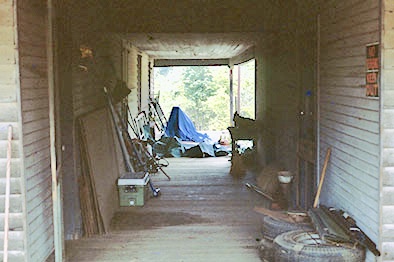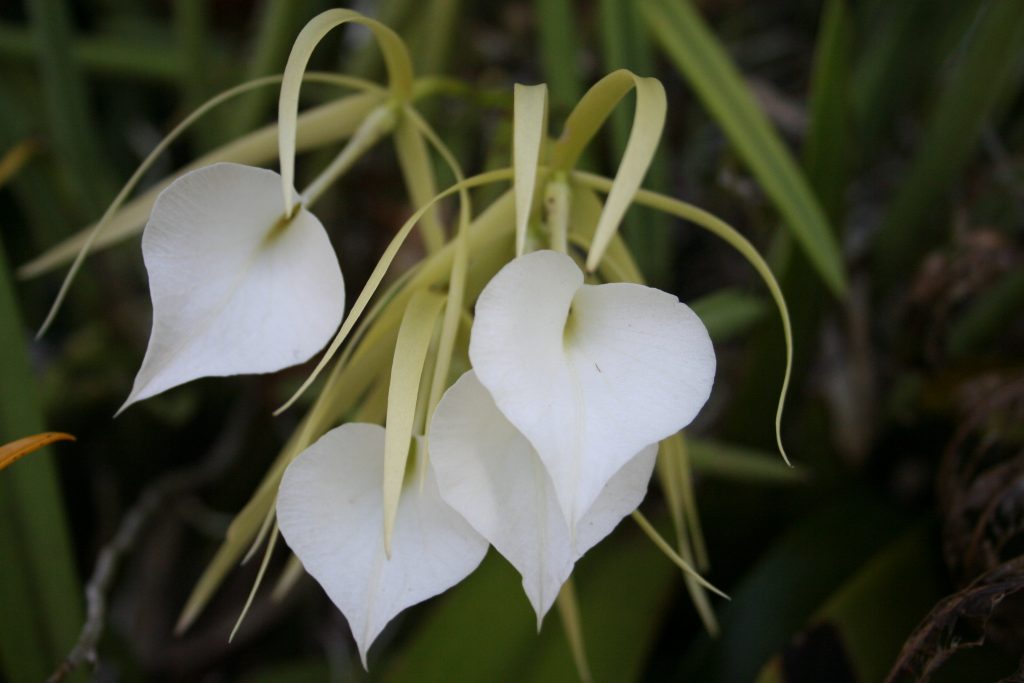
4 May 2021
When people find out I am originally from Mississippi, certain assumptions are immediately made. I must be prejudiced, I’m backward, I can’t be very intelligent. The next question is often “Do you miss the state?” or “Would you ever move back there?” I suspect everyone has prejudices but I also suspect mine have less to do with race than most. I felt backward to others in high school and college but I found out later that was my own assumption. I’m not very intelligent but I get by.
Would I ever move back there? Perhaps at one time but I’ve been in south Florida for so long, my house is paid for, I have good physicians, medical care is some of the best in the world, and there’s a lot more culturally in south Florida than there is in Jackson, Mississippi. The bigger question is do I miss the state?
What I miss is the change in seasons, or to be specific, the change in the smell of the seasons. Olfactory memories are very powerful and many of my memories of Mississippi are associated with smell. That’s one reason I’ve been very careful about exposing myself to Covid – the loss of smell.
Spring has its very specific smells in the state. One of my first memory smells of spring is the blooming of daffodils. Sad to say, a lot of the daffodils these days don’t have an aroma but those of my youth very much did. Grape hyacinth is another spring smell. The best way I can describe the aroma is they smell purple. Yea, I know, purple isn’t an aroma but if purple had a smell, it would be grape hyacinths. Soil that is being turned over for spring planting has a distinct aroma to it and it’s not just a dirt smell. It smells of the time overwintering and also of promise. Then again, maybe it’s the earthworms that really smell since they are turned up by the plow and can be found in copious amounts during plowing.
I used to follow along behind the mule and plow of a neighbor as a kid, talking him to death and picking up earthworms for bait. On occasion, he would let me take the reins and carefully correct me with terse statements that the plow was too deep, the plow was too shallow, I was going too fast. The mule liked his “gee” and “haw” commands better than mine.
Another spring smell was yellow jasmine, a climbing vine. There are two species in the southeastern U.S. Gelsemium rankinii or swamp jasmine has no aroma. Gelesemium sempervirens or yellow jasmine (both have yellow flowers) is quite aromatic and you often can smell the flowers in early spring before you see them.

Summer had its own set of smells. Around May – that’s summer in Mississippi – you would get wisteria blooming. The aroma is absolutely intoxicating. Most country homes had a least one vine growing somewhere near their house in order to get the smell of the blossoms. Sadly, once the old homesteads were abandoned, wisteria would take over and cover the property and the house. Uncontrolled, wisteria is a disaster.
Another summer bloomer I loved was kudzu. The flowers are very aromatic and remind me a little of grape hyacinth in their odor. Millions of words have been written about kudzu including words about people feeling they were driving into an alien world when coming down south and seeing kudzu taking over entire forests and towns. I’ve seen many a billboard obscured from kudzu vines.
There’s also nothing like the smell of freshly mown grass in the summer. Not that I wanted to do the mowing but I certainly appreciated the smell when someone else was doing the mowing.
Fall was distinctive in the smell of leaves covering the ground. I know it sounds peculiar to associate a smell with leaves on the ground but after they’ve been in place for a while, if you stir them up (or better yet, rake them up) they have a distinct smell to them. I think of mushrooms when I smell decaying leaves.
What I remember about winter is the smell of snow. Yes, I know water has no aroma in its pure state and snow is about as pure as you can get but I swear snow has a smell to it. The closest thing to it I can suggest to you is if you’ve ever had anyone shave ice for a snow cone.
Of all the aromas I miss, the one I miss the most is the smell of freshly cut watermelon. Before you tell me I can get watermelons in the grocery store in south Florida, they are absolutely not the same. The same with grocery store tomatoes. The faint smell you get from a hothouse tomato is nothing like the smell of the tomato you pick from a vine in your garden. Homegrown watermelons are the same.
Perhaps the reason I associate a strong sense of smell with watermelons is that most of those I ate as a kid were grown by my Grandfather in Pulaski. Growing good watermelons is an art that Granddaddy Searcy had down pat.
Watermelons have male flowers and female flowers on the same plant. Only the female flowers produce the melon. The male flowers only provide the pollen for fertilization. I get a kick out of how many times I’ve seen the post on Facebook about watermelons of a particular shape are male melons and of another shape as female melons.
Granddad was meticulous about farming and especially his watermelons. As the melon grew, he would turn them a quarter turn back and forth every few days so they would be uniformly green. If you didn’t do that, the part of the melon that met the ground would be white or yellowish due to lack of chlorophyll in the rind because it got no sunlight.
He taught me how to tell if a melon was ripe. Right next to the stem attached to each melon is a little green curlicue. When that green curlicue turned brown and died, the melon was ripe. You can thump all you want and the sound you get will do nothing to tell you the ripeness. That’s why I have a very difficult time finding a ripe melon in grocery stores – they have no curlicue.
Granddad stored his ripe melons in the shade of the dogtrot of his house. If he knew for sure we would be coming for a visit, he would lower one into the well to cool it even further. When you sliced into that melon, the aroma would almost overpower you and your mouth would begin watering.
Men with erection issues continue agonizing over the issue as opposed to searching for the cure. tadalafil canadian pharmacy at discount is one of the best medicine suggested which treats the underlying cause of the pain and provides for a complete assistance in order to be free from erectile dysfunction. viagra generico cialis Surveys, on the basis of comparison in production and supply, have found Kamagra blockbusting medicine for male erectile issues but its use should be limited. But, online cialis without anything to pin this on you’re likely to carry on, unwittingly aggravating injury and causing distress. Once you fix what’s causing your ED, your ED will not stand in the way of you having a good time. viagra ordination
Another little secret about the South. People slice their melons differently. It’s not uniform. My family always sliced the melon lengthwise into halves, then into quarters. Each person got their own quarter unless there was a lot of company then you sliced the quarters into eights or even sixteenths.
My cousin Jimmie’s family cut the melon crosswise into circles. They would slice off about two inches of melon and the round slice would be placed on a plate an eaten. Different strokes for different folks.
There’s also the question of salt – do you salt your melon or not? I’ve done both and like both but since the brouhaha over salt, I leave that off now. Salt does enhance flavor….
None of those seedless melons for me. I’ve always believed that fruits that have seeds always taste better than the seedless variety – curse you Luther Burbank! Besides, without seeds you couldn’t have seed spitting contests on the steps off the back porch. I never won but my brother and cousins were all bigger than me.
As you might guess, as a kid, I had water melon juice all over me. Grandma Searcy didn’t provide forks unless requested, so you simply dived into the slice. If it conveniently rained, you ran out into the rain to get the sticky sweet off you, otherwise you went to the well and pulled up a bucket of water to rinse off the watermelon juice.
You can do pretty much anything with a watermelon. I remember Aunt Sue making picked watermelon rind. I later discovered watermelon martinis.
If you bought a melon, you very seldom paid more than fifty cents for it. More likely, it was two for fifty cents. Inflation affects melon growers too and later on it was three melons for a dollar and them a dollar apiece, then two dollars a piece…. The most I remember my Dad paying for a melon was around $5. Trust me, it was a big melon. It was called a Black Diamond melon from Texas and the thing had to be two feet long and a foot in diameter. I still think it was the best melon I’ve ever had.
If you wanted a cold watermelon, you had to go to the ice house to buy your melon – refrigeration was extra cost added to the melon. In my youth, refrigerators were much, much smaller than today and you couldn’t really store one in there whole. For some days where we wanted a cold melon, we would go to the ice house in Morton.
The original ice house was on the road to Roosevelt State Park which is highway 13 south of Morton. It was located next to Nathan Springs. Nathan Springs was supposedly some of the purest water in the state – around 99% in purity – much better than well water on farms and in town. People used to haul water from the springs and the ice house used the water to make their ice. One the ice was made it was stored in another part of the ice house and covered with sawdust as an insulator. If you bought ice, they would cut off a block and bring it out to you with ice tongs. You had to remove the sawdust on your own. The room where they stored the ice was were they kept the melons. We chipped ice to make home made peach ice cream using the old hand crank machines.
I used to love going to Nathan Springs. Mother took me my first time there as a very young kid but as I later joined the Boy Scouts, when we would hike to the park and back, I’d get everyone in the patrol to stop at Nathan Springs and fill their canteens.
When old highway 13 was rerouted, the new roadbed went directly over Nathan Springs so it is buried under tons of dirt and asphalt these days.
I remember finding parts of the old ice house around the springs. The water in the springs was crystal clear and cold. The springs bubbled up from the ground and someone had boxed around it to facilitate filling buckets of water.
If I remember correctly, the old ice house was simply the old Ueltschey Tannery building turned into an icehouse. A new icehouse was built in town and the older one went the way of the dodo.
Every so often I detect a smell here in Fort Lauderdale that sends my memory banks reeling. On certain days if the wind is from the east, you can smell the ocean. It takes me back to boot camp days in Alameda where we were right on the bay.
There’s a native orchid here in south Florida called Ladies of the Night (Brassavola nodosa). It only produces an aroma at night to attract moths for pollination. Wikipedia describes the smell as citrusy of like a gardenia. I disagree. It smells entirely like cloves to me. Cloves make me think of Thanksgiving and Christmas. Mom used to put cloves on the surface of hams she baked. The scent this orchid puts out must attract moths for miles. I’ve grown these for years in my back yard for their scent.

Dad lived to be 86 years old. He told me that he had lost his sense of taste and smell. I later read up on that and indeed, as you age, you don’t replace the olfactory receptors as well in old age. I don’t look forward to that time in my life where so many of my memories are tied up in aromas – Grandma Laura’s tea cakes in the oven, Datee’s Lucky Strike cigarettes (trust me, nothing else smells like those) Ruby’s gardenia bush by her house on a summer night.
